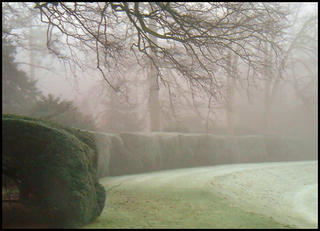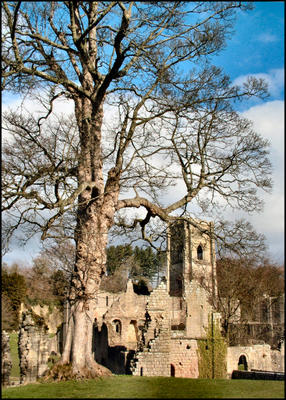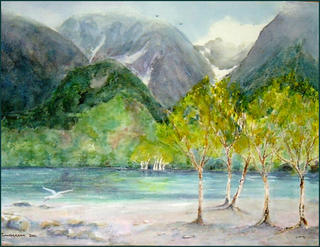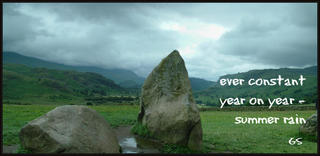No, for sheer, stark beauty in the landscape, winter takes a lot of beating. If you are the kind of walker or photographer who puts away the boots and camera at the first sniff of cold air, and heads for the best armchair and the TV schedules - let me show you a little of the beauty of my part of North Yorkshire, more specifically that of the Fountains Abbey and Studley Royal estate. This isn't the time to recount the long history of this fascinating place - more of that one day; suffice it to say that it is a World Heritage Site, visited by people from many parts of the world, and that we are lucky enough to live a short drive away from it.

Strolling through the deer park at Studley Royal on a bitingly-cold December day, I saw this estate farm-house 'caught' between the branches of a tree. Pulling off warm fleece gloves and standing still long enough to compose and shoot photographs in these conditions takes some dedication, I admit; but if I hadn't put up with the discomfort, I would have missed this image of that beautifull freize of trees set against the winter sky. In high summer this shot wouldn't have been worth taking, but in the depth of winter we can see the full beauty of the bare structure of the trees.
*********************
Fountains Abbey Ruins from the south
~~~~~~~~~~~~
The best days for dramatic photography are not those which start with bright sunlight and clear skies, but those which begin with thick clouds and heavy rainstorms. Quite often I find - in my part of England - that the storm passes by late afternoon, leaving fascinating varied and many-hued cloud masses with blue sky breaking through.
It was on such a day in March that I took this photograph of the abbey ruins. I wanted to combine the image of this magnificent field maple spreading its bare branches against the stormy sky, with that of the ruins sitting calm and steadfast in this valley - as they have continued to do for some 800 years now.
Symet-Tree
******
An awfull pun, I admit - but I always think of this as the symet-tree, for obvious reasons. Jill tells me that it's a specimen beech tree; all I know is that it keeps this perfect shape all year round. It is beautiful at any time of year, but reveals a special kind of ethereal loveliness on days like this, when freezing mist cloaks everything in mystery. If you look closely, you can see the ruined wall and window openings of the Abbey guest wing, emerging ghost-like through the skeleton of the tree - an image to be seen only in the depths of winter.
The Yew Hedge ~ Hoar Frost
~~~~~~~~~~~~~

On the same day that I photographed the 'symet-tree' - a day of hoar frost, when one tried not to breathe too deeply, as every breath seared the lungs with intense cold - I was walking along, thinking longingly of hot tea and central-heating, when Jill grasped my arm and said 'Take a photograph of this for me, please.' With her artists eye, she had spotted the design possibilities of this yew hedge, which curved away round the nearby ornamental pond and slowly disappeared into the mist. We both found the contrast between the regularity of the hedge and the random nature of the dark branches, all modulated by the freezing mist, quite irresistable. Jill has been largely responsible for educating my eye like this, leading me to study composition as an aid to taking more appealing photographs.
.......................................................................................................................
Snowdrops
As Winter draws to a close, we have the flowers of early spring to look forward to; but before the golden delight of daffodills, there are the snowdrops - often pushing through late snowfall. Throughout the woods lining the valley of the River Skell - with Fountains Abbey at its head - countless thousands of them carpet the floor; so many that they reflect the light up into the bare branches, making the woods shimmer in the late winter sun.
%%%%%%%%%%
St Mary's, StudleyRoyal - now deconsecrated - was built as a private estate church in 1871, the architect being William Burgess, who was renowned as the master of the High Victorian Gothic Revival style. The interior is a masterpiece of design and colour, but few of the many thousands who pass it give it more than a glance, little guessing what lies inside. But it was the building itself - sitting boldly at the head of a drive which stretches through the deer park clear to Ripon Cathedral two miles away - which caught my eye, framed as it was by the bare branches of another magnificent tree set against a turbulent winter sky. With this tree in its summer foliage, the church would have been scarcely visible
~~~~~~~~~~~~~~~~~~~~~~~~~~~~~~~~~~~~~~~~~~~~~~~~~~~~~
Most images are completely satisfying in themselves - that is, if they have been captured with a view to presenting the subject so as to create in the viewer's mind the emotions that the photographer felt at the time he or she 'saw' the photograph. But sometimes an image - often when viewed again years after creation - promotes different feelings in the mind. With my recently-found interest in haiga, I find that words form, suggesting a haiku which will stand alone seperately from the image, but which has a special meaning when combined with it.
So it was with my final photograph in this 'Winter' collection. One December day we were walking around the large ornamental lake at the edge of the deer park, when a stray shaft of sunlight escaped from dark clouds, illuminating the stark branches set against the dark surface of the lake. In the distance a flock of gulls had settled in a line against the far shore, resting before continuing their journey. Only recently, while searching through my files for winter photographs, did I come across this image, and added the short poem to create this haiga.
~ a brief halt on this long journey - December afternoon ~

I hope that I've been able to convince you that winter can be the most beautiful of seasons ~ enjoy the next one!
*****************
















